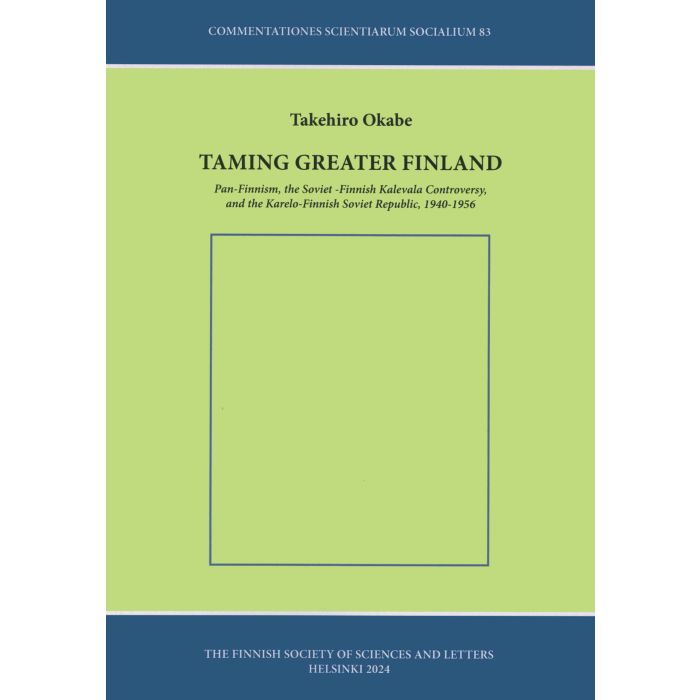Vi använder cookies för att göra din upplevelse bättre. För att följa det nya direktivet om e-integritet, behöver vi be om ditt medgivande att sätta cookies. Läs mer.
Taming Greater Finland
Special Price
24,00 €
Normalt pris
30,00 €
I lager
SKU
978-951-653-514-5
Okabe, Takehiro
Taming Greater Finland. Pan-Finnism, the Soviet -Finnish Kalevala Controversy, and the Karelo-Finnish Soviet Republic, 1940-1956
Finska Vetenskaps-Societeten - Suomen Tiedeseura
Commentationes Scientiarum Socialium 83
s.l. 2024, 295 pp.
Taming Greater Finland. Pan-Finnism, the Soviet -Finnish Kalevala Controversy, and the Karelo-Finnish Soviet Republic, 1940-1956
Finska Vetenskaps-Societeten - Suomen Tiedeseura
Commentationes Scientiarum Socialium 83
s.l. 2024, 295 pp.
To whom do the Kalevala and its epic poems belong? Where are the origins of the epic poems? How do we understand the relationship between Finns and Karelians? Is the Finnish language closely related to the Karelian language? These questions were intensively discussed not only in Finland but also in the Soviet Union, and between Finland and the Soviet Union, in the 1940s and 1950s.
This dissertation addresses repertories of Soviet imperial rule in Soviet Karelia, where the Karelo-Finnish Soviet Socialist Republic existed from 1940 to 1956, by scrutinizing the controversy over the Kalevala and pan-Finnik kinship among Soviet intellectuals in Soviet Karelia, Leningrad, and Moscow and between Soviet and Finnish intellectuals.
The dissertation is based on varieties of archival materials from Russia, Finland, and Estonia to understand how the Soviet Union grafted pan-Finnic ideology/”heimoaate” onto the Soviet national ideology to justify its rule in Soviet Karelia and influence Finland to challenge Finland and the Finns to claim the central place of the Baltic-Finnic world after the Second World War.
This doctoral dissertation argues that the Soviet Union "tamed" Greater Finland by picking up useful elements -in particular the pan-Finnism ideology and hierarchy- from it to justify its rule in the Soviet-Finnish borderlands, as the Finns did before and during the Second World War. The dissertation also demonstrates how Soviet Finns, Karelians, and Veps held multiple positions to resist and challenge the pan-Finnism ideology and hierarchy which the 'collusion' between the Soviet Union and Finland imposed on them.
This dissertation addresses repertories of Soviet imperial rule in Soviet Karelia, where the Karelo-Finnish Soviet Socialist Republic existed from 1940 to 1956, by scrutinizing the controversy over the Kalevala and pan-Finnik kinship among Soviet intellectuals in Soviet Karelia, Leningrad, and Moscow and between Soviet and Finnish intellectuals.
The dissertation is based on varieties of archival materials from Russia, Finland, and Estonia to understand how the Soviet Union grafted pan-Finnic ideology/”heimoaate” onto the Soviet national ideology to justify its rule in Soviet Karelia and influence Finland to challenge Finland and the Finns to claim the central place of the Baltic-Finnic world after the Second World War.
This doctoral dissertation argues that the Soviet Union "tamed" Greater Finland by picking up useful elements -in particular the pan-Finnism ideology and hierarchy- from it to justify its rule in the Soviet-Finnish borderlands, as the Finns did before and during the Second World War. The dissertation also demonstrates how Soviet Finns, Karelians, and Veps held multiple positions to resist and challenge the pan-Finnism ideology and hierarchy which the 'collusion' between the Soviet Union and Finland imposed on them.
| Förläggare | Finska Vetenskaps-Societeten |
|---|---|
| ISBN | 978-951-653-514-5 |
| ISSN | 0355-256X |
| Publikationsserie | Commentationes Scientiarum Socialium |
| Sarjanro | 83 |
| Tryckt (år) | 2024 |
| Publikationens omslag | Mjuk pärm |
| Bandtyp | Häftad |
| Språk | engelska |
| Vetenskapsgrenar | Historia, Litteraturvetenskap, Kulturvetenskap |


